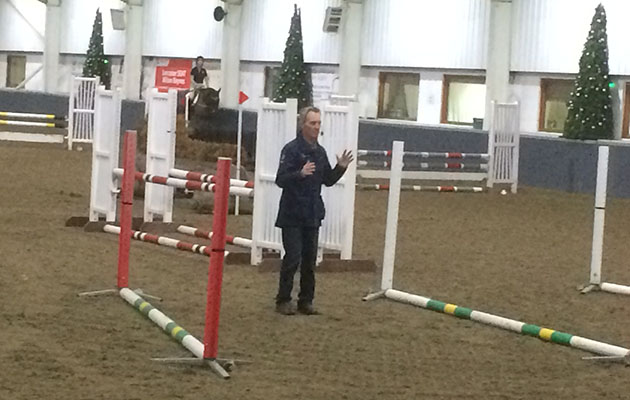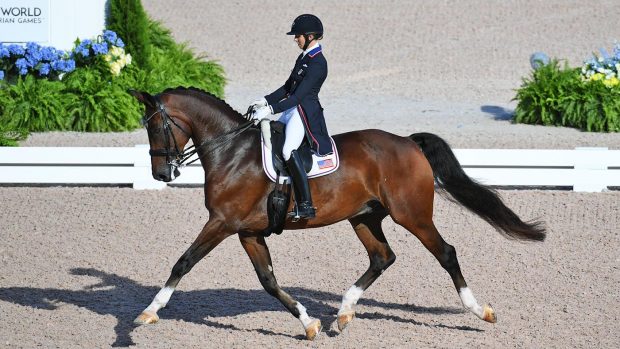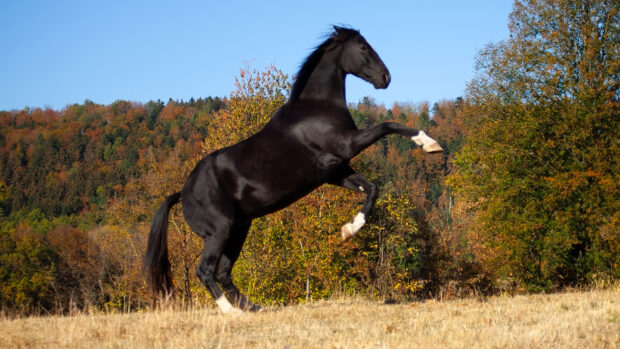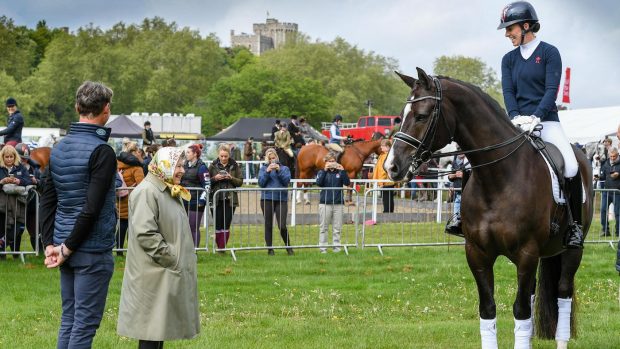Irish Olympian and Fellow of the British Horse Society Eric Smiley launched his new book Two Brains One Aim, written with freelance journalist Ellie Hughes, at the recent International Eventing Forum (4 February).
In this extract of Two Brains One Aim, Eric discusses how the bits horses wear can impact on cross-country safety:
I first noticed the desire to achieve greater control when the minimum weight restriction was removed from the eventing cross-country phase in 1998 (previously all horses had to carry 165lbs (75kg), made up with lead weight if necessary, for the cross-country phase). At the same time, courses started becoming more technical. These two changes brought control into focus as lighter riders were now riding big, “scopey” horses, and they needed better control to negotiate the more technical courses. The short fix was to find a bit that offered more control.
A similar thing happened in show jumping. Bigger jumping horses were introduced — they were not necessarily better or more careful, they just had bigger jumps. Courses became more technical, so there became a need to control these horses.
In dressage, the desire for control has taken a different route. While there have been adaptations to the snaffle and double bridles, these two pieces of tack have remained a constant. Crank nosebands and hyperflexion have become the focus.
When it comes to bits there has always been a fashion, a “must have,” a “follow the trend.” Bit manufacturers see opportunities in the market and take them, convincing the uninitiated that a certain bit will make all the difference because it is “kinder to the horse” or “more natural.”
Bitting to gain control produces problems for everyone, from the happy hacker to the upper level rider. Coaches must feel like they are swimming against a tide when they advocate correct acceptance and understanding of the rider’s aids, and instead, see three-rings, pulleys, and big hunks of metal. The welfare and integrity of the horse remain paramount, but, at times, it seems this has been replaced by the need for control at all costs.
When double bridles were permitted in the dressage phase of eventing, riders saw this as an opportunity to gain the control they felt they were missing in a snaffle. Thank goodness this trend has been identified and rule changes seem to be coming in to rectify this. In show jumping it appears that riders will resort to anything in order to gain control, provided it is within the rules.
Every discipline has its own requirements and some would say that it is not possible to draw comparisons. But I think there are similarities and that it is important for us all to seek a moral common ground.
We all want a nice riding horse: one that goes, stops, and turns on request. When asked to jump, we want the horse to know what to do. When asked to gallop, we don’t want him to run away. In dressage, the “Carl Hester effect” has changed the face of the discipline throughout the world. To watch and listen to this brilliant horseman should be a must for all riders. In time, the ethical way of training that Carl so inspires will filter right through the sport at all levels.
Does the end justify the means? No, of course not, but we need to be careful to supervise that it does not. At this year’s Junior and Young Rider European Championships for all disciplines, I was able to watch each discipline warm up for their respective classes; because of the age grouping most riders had trainers. Indeed that’s why I was there. I was struck by the difficulty the stewards have in enforcing the rules. Not so much when they are clearly defined (as in show jumping), but more so the interpretation of the rules in the dressage warm-up. Each rider had a headset on and was being instructed by her trainer. In many cases, it amounted to “supervised bullying” of the horse with a high degree of “mental cruelty” — always on the edge of the rules and their interpretation. Hyperflexion, excessive use of spur and or whip, seeking “false paces” in place of correct and ethical schooling.
Classical principles dating to Xenophon some 2400 years ago should still be upheld today:
1 That the horse should be allowed to develop naturally.
2 That force should not be used.
3 That the result should be beautiful and beautifully easy to watch.
In show jumping, jumping clear is the aim. The issue of making horses careful is, and always will be, part of the sport. The ethics of how this is achieved is open to much debate. Bits and bitting can be a part of this.
But it is for eventing that I have my main concern with the misuse of bits. In dressage and show jumping there are undoubtedly issues, but cross-country there is far more danger lurking.
“Fake” Control
Horses are not natural gallopers. Their instinct allows them to sprint, but they must be taught to gallop, just as they are taught to walk, trot, and canter. To perform in all gaits in harmony and control should be every rider’s aim. Without this harmony and understanding, we open a Pandora’s box of possible problems.
Asking a horse to gallop at Preliminary (US) or Novice (UK) cross-country speed of 520mpm before he is comfortable with a fast canter (350–400mpm) has every chance of triggering his natural response of “run.” The moment speed becomes a conditioned response to the rider shortening her stirrups and getting into an open space, the rider feels the need to control it. Now problems arise and the perception is that brakes are needed.
The range of bits and gadgets is endless. Some of the most popular are:
➤ The three-ring or bubble bit.
➤ The elevator.
➤ Rings and pulley reins in various forms.
➤ Curb chains — excessively tight.
Every one of these is a potential disaster waiting to happen!
The aim of flatwork training is to produce a nice riding horse for all occasions. As the topline is rounded to encourage the horse “through” from leg to hand, an acceptance and understanding of the aid is produced. This harmony must also be present cross-country.
The bits I have listed above, and others like them, have an action that encourages hollowness in the horse’s way of going that is detrimental both on the flat and over fences. Not every horse has a natural bascule over a jump — and we should make every effort to work with what the horse is given and encourage him to buy in to what he has to do to jump. But by using bits that encourage an incorrect way of going, we create many problems for ourselves and the horse:
➤ The jaw shows resistance.
➤ The head comes up.
➤ The neck goes hollow.
➤ The shoulders become blocked.
➤ The steering becomes delayed and unresponsive.
➤ The back becomes less “through.”
➤ The rider stops using her legs for fear of more speed.
➤ The horse’s hind legs are less engaged.
➤ The rider’s hands become the dominant aid.
And so it goes on.
The problems that occur when hollowness appears can manifest in different ways:
➤ Lack of roundness to a jump.
➤ Dragging of hind legs (causing poles to fall down behind).
➤ Tight shoulders (causing more poles down in front).
➤ Tight shoulders (causing more chance of hitting solid fences).
➤ More stand-offs or long spots.
➤ More speed, less impulsion.
Spend a day watching cross-country and you will see some unsightly pictures. Look more closely and there is also a trend: most of the ugly sights are control issues. Look more closely and you will see these control issues will also have a bit issue. Course designers cannot make the jumping phases of eventing higher or wider in their effort to separate competitors, so they have had to use their imagination to test the control of horse and rider.
Course designers explore the concepts of the control of line and pace, the control of accuracy, and the riders’ training of their horse in answering this control.
Coaching riders and horses to meet these challenges of control requires skill, but there is a perception that this increase in skill is a euphemism for more control. More control can come from an improvement in the way the partnership works together, or it can be tack-induced. The latter is a shortcut. This is not to say that a change in tack can never make a difference for the better, but it is important to know how to retain the good qualities when in control and not to just “be in control”! There is too much of the latter.
A lot of our everyday problems are directly attributable to bits and bitting. Moreover, only a handful of top riders are skilled enough to “cope” with the issues created by bitting, leaving the rest to struggle with the consequences of these issues.
When Cross-Country Becomes Dangerous
Good cross-country horses look, think, and react. To the rider who says, “He’ll jump anything,” I reply, “That’s not always a good thing.”
To produce a suitable canter or gallop, the horse must allow himself to be balanced by accepting the rider’s leg aids. These aids should engage the hind end in a way that doesn’t produce speed, but encourages the horse to accept the contact and the resulting adjustment to speed in a round and rideable way. Failure to do this makes it difficult for the horse to see, assess, and take responsibility for his part in the jump.
Imagine a car with its accelerator stuck on and the brake as the only regulator of speed. The driver would survive for a short time but very soon the brakes would overheat and fail. This is what happens to over-bitted horses — it is called “running through the bridle” — and it can have frightening results.
Hollowness over solid fences is a problem in itself, but add in a drop behind and safety becomes a very real issue. When the horse is unable to see what he has to do until the last second, he will not be able to react quickly enough to stay safe. Furthermore, the way the horse is likely to hit the fence will be with his forelegs above the knee. This is the type of impact that often causes a rotational fall or a fall on landing as the horse is unable to get his undercarriage under control.
There is an indisputable link between bitting and falls. As the rider endeavors to regain control and balance in front of a fence, the horse inverts and so the ability to ride from the leg to the rein diminishes. The takeoff becomes uncertain, spreads become a lottery, distances in combinations become short, and the “out” element becomes very chancy. A blow on the horse’s forearm could be the result, and with it, the risk of a serious fall.
Where to buy Two Brains One Aim: Two Brains One Aim can be purchased at Amazon.
Two Brains One Aim is published by Quiller Publishing, 2019
You might also like:

Does your bit fit? How to measure your horse’s mouth size

Chris Bartle’s top tips to perfect your cross-country position
Maintaining rider balance and position can be the difference between a winning performance and cross-country penalties

10 terrifying moments when riders’ tack has broken in competition
A snapped stirrup or rein is the stuff of nightmares — check out these instances when it happened to some

Subscribe to Horse & Hound magazine today – and enjoy unlimited website access all year round
Horse & Hound magazine, out every Thursday, is packed with all the latest news and reports, as well as interviews, specials, nostalgia, vet and training advice. Find how you can enjoy the magazine delivered to your door every week, plus options to upgrade your subscription to access our online service that brings you breaking news and reports as well as other benefits.




